If you're one of those dual-sport riders who looks at the latest batch of adventure-touring bikes and scoffs at their 600-pound curb weights and vulnerable vitals, Husqvarna 's FE 350 S and FE 501 S are a breath of fresh air. Based on the Swedish firm's capable FE 350 and FE 501 enduro models (which, in turn, are near carbon copies of parent-company KTM 's EXC machines), the 350 S and 501 S are for all intents and purposes woods bikes with lights and license plates. Just one look at the Huskys tells you that these lean singles reside at the other end of the dual-sport spectrum from their big-boned, multi-cylinder ADV brethren.
Diehards will be pleased to learn that the FEs were minimally modified for the road. The essential DOT and EPA items were attended to, plus minor suspension and engine tweaks to yield smoother power delivery and better traction on dual-purpose rubber. The 350cc DOHC FE 350 S gained some crank mass, while the 510cc 501—with its SOHC design and titanium intake valves and steel exhaust valves—goes unchanged from its FE 501 off-road counterpart save for a more durable three-layer head gasket.
The 350 and 501 share similar steel-tube frames with light and durable polyamide subframes and one-piece cast-aluminum swingarms. Suspension is from WP, with a beefy fork up front and a DCC (Dual Compression Control) linked shock in the rear.
Final-drive gearing was altered to yield more relaxed on-road travel, though both bikes still vibrate your boots and butt at highway speeds, while the handlebar wags in your hands as the knobbies wander down the road. Either bike will get you from Point A to Point B (though the 510cc 501 S is, as expected, quite a bit faster), but on-road travel obviously isn’t this pair’s mission.
Point either machine’s 21-inch front wheel toward the dirt and all becomes right. The 350 is wonderfully light, narrow, and agile, and has around a foot of well-calibrated suspension travel available to soak up big hits. The engine is less lively than expected, but low-end torque is strong and the top-end power (the 350 revs to 12,000 rpm!) is impressive. Both the 350 and 501 utilize a DDS (Damped Diaphragm Steel) clutch with hydraulic actuation. Clutch action is light and progressive, which is a good thing since you work the gearbox quite a bit on the 350—the motor doesn’t quite have enough flywheel to keep from stalling during low-speed maneuvers or while feathering the rear brake entering corners.
The 501 offers significantly more power. It’s snappier off the bottom, and the bigger engine’s extra torque meant less gear shifts while climbing up into the Santa Rosa-San Jacinto Mountains east of Husqvarna’s Murrieta, California, headquarters. However, on some of the steeper, sandier stretches of fire road the 501 was quick to spin the rear tire—running a gear high helped ensure forward progress. On faster, harder-packed roads, the 501’s ability to break traction made steering with the rear a suitable method for finishing corners, and its knack for lofting front wheel in just about any gear was a definite advantage.
The only downside to the 501 is slightly heavier handling. According to Husqvarna, the 350 S and 501 S are separated by just 8 pounds (claimed dry weight is 243 and 251 pounds, respectively), but once you get the 501’s crank spinning that bike takes a bit more muscle to change directions. It’s only a minor difference, and considering there’s only a minor difference in the FES’s prices—$10,049 for the FE 350 S and $10,249 for the FE 501 S—the bigger bike is the way to go.
Brake calipers are from Brembo and the discs from Galfer, the dash is from Trail Tech, and the cranks come from Pankl. The triple clamps are machined and the engine cases have the sort of finish on them that you’d expect to see on works racers. These are premium bikes, and deliver in terms of performance and appearance. The only area where Husky missed the mark is where your backside meets the bike. The seat is a board! That’s not much of a concern when you’re posted up on the pegs attacking your favorite trail, but even around town you’ll be cursing that stiff saddle.
But hey, real off-road bikes aren’t meant to be comfortable. Leave that to those overweight ADVs.











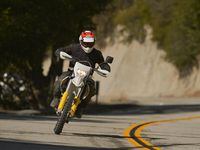
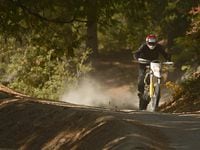
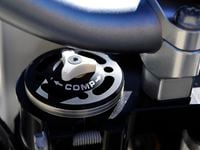


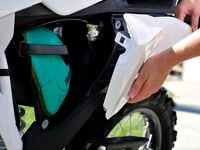

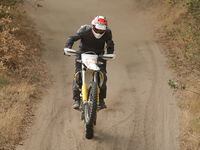
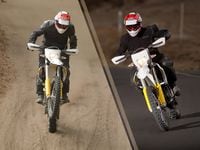

/cloudfront-us-east-1.images.arcpublishing.com/octane/TNOU5DNE2BC57MFPMGN2EIDXAM.jpg)
/cloudfront-us-east-1.images.arcpublishing.com/octane/GTCXACQGJ5HAPDTGWUQKDEH44E.jpg)
/cloudfront-us-east-1.images.arcpublishing.com/octane/S35YGSEMEZB4BLTDJTSZPF4GLA.jpg)
/cloudfront-us-east-1.images.arcpublishing.com/octane/5UOT6HPX2JFMRJAX6EH45AR4MQ.jpg)
/cloudfront-us-east-1.images.arcpublishing.com/octane/OKWOJWAKP5EP3OACCRRWPCIX2Q.jpg)
/cloudfront-us-east-1.images.arcpublishing.com/octane/2WF3SCE3NFBQXLDNJM7KMXA45E.jpg)
/cloudfront-us-east-1.images.arcpublishing.com/octane/G4MG6OUCJNBSHIS2MVVOTPX65E.jpg)
/cloudfront-us-east-1.images.arcpublishing.com/octane/IIGGWFOTOJGB7DB6DGBXCCMTDY.jpg)
/cloudfront-us-east-1.images.arcpublishing.com/octane/QSTCM6AVEZA5JJBUXNIQ3DSOF4.jpg)
/cloudfront-us-east-1.images.arcpublishing.com/octane/U4I7G625B5DMLF2DVIJDFZVV6M.jpg)
/cloudfront-us-east-1.images.arcpublishing.com/octane/B6XD6LS6IVCQPIU6HXDJSM3FHY.jpg)
/cloudfront-us-east-1.images.arcpublishing.com/octane/ICL63FEDDRDTTMINYICCEYGMDA.jpg)
/cloudfront-us-east-1.images.arcpublishing.com/octane/FCGZHQXRBZFLBAPC5SDIQLVF4I.jpg)
/cloudfront-us-east-1.images.arcpublishing.com/octane/WNOB6LDOIFFHJKPSVIWDYUGOPM.jpg)

/cloudfront-us-east-1.images.arcpublishing.com/octane/X33NU3E525ECRHXLNUJN2FTRKI.jpg)
/cloudfront-us-east-1.images.arcpublishing.com/octane/6KKT5NNL2JAVBOXMZYS5ZO76YA.jpg)
/cloudfront-us-east-1.images.arcpublishing.com/octane/J5RKG5O455GMPGQRF2OG6LRT7A.jpg)
/cloudfront-us-east-1.images.arcpublishing.com/octane/GX2CIZKQVRH2TATDM26KFG2DAE.jpg)
/cloudfront-us-east-1.images.arcpublishing.com/octane/ZWIDYSAKQZHD5BHREMQILXJCGM.jpg)
/cloudfront-us-east-1.images.arcpublishing.com/octane/CYUHJZCTSJCH3MRAQEIKXK7SCQ.jpg)
/cloudfront-us-east-1.images.arcpublishing.com/octane/LKOFINY56FCXJCANJ5M7ZDQUBY.jpg)
/cloudfront-us-east-1.images.arcpublishing.com/octane/4NBPDACMWJH63JQYJVK3QRBDZI.jpg)
/cloudfront-us-east-1.images.arcpublishing.com/octane/KKHQHRR3FJGX7H2IPU6RALMWG4.jpg)